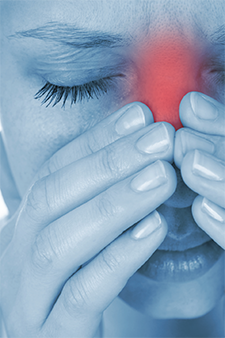
Approximately 25% of patients with olfactory disturbances have CRS.
milias1987/shutterstock.com
Explore This Issue
July 2016Antibiotic Exposure and CRS
Alice Z. Maxfield, MD, a rhinology fellow in the department of otolaryngology at Massachusetts General Hospital in Boston, suggested in the first presentation that general antibiotic exposure is a significant risk factor for the development of chronic rhinosinusitis (CRS). She began by explaining that antibiotic use is associated with multiple adverse effects, including allergy, widespread antibiotic resistance, and infection with Clostridium difficile and Candida albicans, as well as loss of microbial diversity. Additionally, CRS is independently associated with the depletion of microbiome diversity and the introduction of opportunistic infections. She and her team hypothesized that the use of antibiotics leads to loss of biodiversity of the sinonasal microbiome, resulting in the development of CRS. Confirmation of their hypothesis would mean that antibiotic use is an unrecognized risk factor for the development of CRS.
The case control study used the STrengthening the Reporting of OBservational studies in Epidemiology (STROBE) guidelines. The investigators studied patients referred to the tertiary Massachusetts Eye and Ear Sinus Center for a range of sinonasal disorders. Of the 1,162 patients studied, 410 were diagnosed with CRS according to established consensus criteria. The remainder (752) were considered controls. The case group was further differentiated into those without nasal polyps (CRSsNP) and those with nasal polyps (CRSwNP). All patients were given a validated quality of life (QOL) questionnaire. Additionally, the class, diagnosis, and timing of previous non-sinusitis-related antibiotic exposures were recorded. The results from the antibiotic exposure questionnaire were also validated using a randomized administrative data review of 452 patient charts. From this data, the investigators calculated the odds ratio of developing CRS following antibiotic exposure as well as the impact of antibiotic use on the subsequent QOL.
The investigators found a higher median age in the case group. They also found that antibiotic use significantly increased the odds of developing CRSsNP. Additionally, antibiotic exposure, as confirmed by antibiotic review, was associated with worse CRS QOL scores over at least the subsequent two years.
Dr. Maxfield said that while microbial diversity in CRS is still controversial, antibiotics may result in long-term consequences. Specifically, the study indicated that the use of antibiotics more than doubles the risk of developing CRSsNP, leading Dr. Maxfield to estimate that antibiotics might be implicated in 25% of the disease burden in their study population and to suggest that CRS may be an unrecognized side effect of antibiotic use.